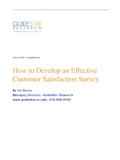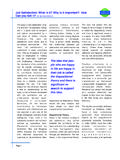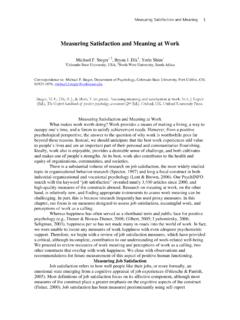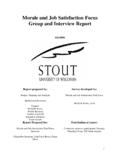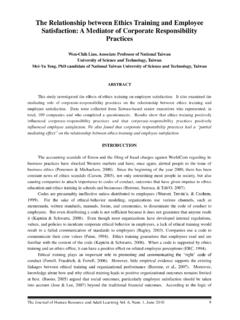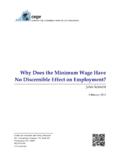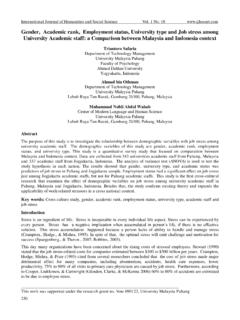Transcription of Employee Satisfaction & Customer Satisfaction
1 WHITE PAPER FEBRUARY 2005. Employee Satisfaction &. Customer Satisfaction : Is There a Relationship? By Caterina C. Bulgarella, , GuideStar Research Analyst GUIDESTAR RESEARCH WHITE PAPER. Employee Satisfaction &. Customer Satisfaction : Is There a Relationship? Numerous empirical studies show a strong positive relationship between Employee Satisfaction and Customer Satisfaction ( , Band, 1988; George, 1990; Reynierse & Harker, 1992; Schmitt &. Allscheid, 1995; Schneider & Bowen, 1985; Schneider, White, & Paul, 1998; Schneider, Ashworth, Higgs, & Carr, 1996 Johnson, 1996; Ulrich, Halbrook, Meder, Stuchlik, & Thorpe, 1991; Wiley, 1991).
2 As suggested by this wealth of findings, positive changes in Employee attitudes lead to positive changes in Customer Satisfaction . Some investigations have provided explicit measures of this relationship. For example, a study at Sears Roebuck & Co. showed that a five-point improvement in Employee attitudes led to a rise in Customer Satisfaction which, in turn, generated a increase in revenues. Brooks (2000). reviewed the relationship between financial success and Customer and Employee variables ( , Customer Satisfaction , Employee Satisfaction , etc.)
3 And found that, depending on market segment and industry, between 40 and 80 percent of Customer Satisfaction and Customer loyalty was accounted for by the relationship between Employee attitudes and Customer -related variables. Similarly, Vilares and Cohelo (2000) found that perceived Employee Satisfaction , perceived Employee loyalty, and perceived Employee commitment had a sizable impact on perceived product quality and on perceived service quality (see model below). Perceived Employee Commitment Perceived Product Quality Perceived Value Perceived Employee Perceived Satisfaction Service Quality Perceived Employee Loyalty Customer Satisfaction GUIDESTAR RESEARCH - WHITE PAPER - FEBRUARY 2005 2.
4 GUIDESTAR RESEARCH WHITE PAPER. According to their model, Employee Satisfaction not only affects Employee commitment and Employee loyalty, but it also has a twofold impact ( , direct and indirect) on critical Customer Satisfaction -related variables. The relationship between Employee Satisfaction and Customer Satisfaction has received further empirical confirmation from two methodologically strong studies. Specifically, a recent meta- analytic investigation (Harter, Schmidt, & Hayes, 2002), based on 7,939 business units in 36.
5 Companies, found generalizable relationships, large enough to have substantial practical value, between unit-level Employee Satisfaction -engagement and business-unit outcomes such as Customer Satisfaction , productivity, profit, Employee turnover, and accidents. Finally, Berhardt, Donthu, and Kennett (2000) measured the relationship between Employee Satisfaction , Customer Satisfaction , and profit longitudinally showing that, although the effects of Employee Satisfaction and Customer Satisfaction on business profit at a given point in time might not be detectable, they become visible and prominent over time.
6 Specifically, these researchers found a positive relationship between change in Customer Satisfaction and change in profit/sales, a positive relationship between change in Employee Satisfaction and change in business profit, and a strong relationship between Employee Satisfaction and Customer Satisfaction at any point in time. Understanding the Relationship Between Employee Satisfaction and Customer Satisfaction The literature offers several explanations as to why Employee Satisfaction affects Customer Satisfaction : 1.
7 Employees that interact with customers are in a position to develop awareness of and respond to Customer goals and needs. 2. Satisfied employees are motivated employees; that is, they have the motivational resources to deliver adequate effort and care. 3. Satisfied employees are empowered employees; in other words, they have the resources, training, and responsibilities to understand and serve Customer needs and demands. 4. Satisfied employees have high energy and willingness to give good service: at a very minimum, they can deliver a more positive perception of the service/product provided.
8 5. Satisfied employees can provide customers with interpersonal sensibility and social account ( , adequate explanations for undesirable outcomes). It has been suggested that these components of interactional justice ( , quality of interpersonal treatment provided in a negotiation/exchange) have a significant impact on Customer Satisfaction . According to this view, because satisfied employees experience interactional justice, they can deliver it; that is, satisfied employees have enough emotional resources to show empathy, understanding, respect, and concern.
9 GUIDESTAR RESEARCH - WHITE PAPER - FEBRUARY 2005 3. GUIDESTAR RESEARCH WHITE PAPER. Organizational Antecedents of Employee Satisfaction and Employee Customer Service Some researchers have focused on organizational antecedents of Employee Satisfaction and Employee Customer service. A model offered by Yoon, Hyun Seo, and Seog Yoon (2000). identifies three antecedents: 1. Perceived organizational support (POS), that is, the extent to which employees perceive that the organization values their contributions and cares about their well-being.
10 2. Perceived supervisory support (PSS), that is, the extent to which supervisors develop a climate of trust, helpfulness, and friendliness; high PSS implies that important socio- emotional resources are immediately available in the work environment. 3. Customer participation, that is, the extent to which a Customer is physically, mentally, and emotionally involved in the delivery of a service/product. At this level, both the resources/information that customers bring into the transaction and the actual behaviors they engage in are important.
